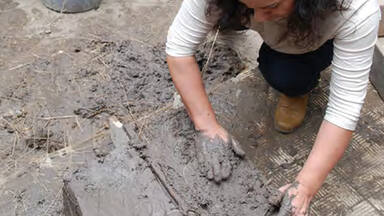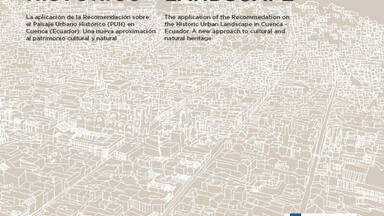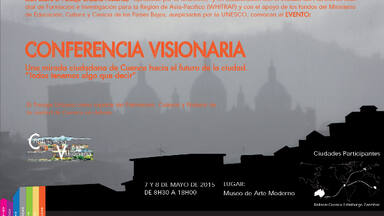Historic Centre of Santa Ana de los Ríos de Cuenca
Historic Centre of Santa Ana de los Ríos de Cuenca
Santa Ana de los Ríos de Cuenca is set in a valley surrounded by the Andean mountains in the south of Ecuador. This inland colonial town (entroterra ), now the country's third city, was founded in 1557 on the rigorous planning guidelines issued 30 years earlier by the Spanish king Charles V. Cuenca still observes the formal orthogonal town plan that it has respected for 400 years. One of the region's agricultural and administrative centres, it has been a melting pot for local and immigrant populations. Cuenca's architecture, much of which dates from the 18th century, was 'modernized' in the economic prosperity of the 19th century as the city became a major exporter of quinine, straw hats and other products.
Description is available under license CC-BY-SA IGO 3.0
Centre historique de Santa Ana de los Ríos de Cuenca
Santa Ana de los Ríos de Cuenca est enchâssée dans une vallée entourée par les Andes, dans le sud de l'Équateur. La ville coloniale de l'intérieur (entroterra ), actuellement troisième ville du pays, a été fondée en 1557 selon les directives d'urbanisme rigoureuses établies trente ans auparavant par Charles Quint, roi d'Espagne. Elle suit le plan orthogonal officiel respecté depuis 400 ans. Centre agricole et administratif de la région, la ville est devenue un lieu de brassage pour les populations locales et immigrantes. L'architecture de Cuenca, qui date en grande partie du XVIIIe siècle, a été « modernisée » lors de la prospérité économique du XIXe siècle, lorsque la ville est devenue grande exportatrice de quinine, de chapeaux de paille et d'autres produits.
Description is available under license CC-BY-SA IGO 3.0
وسط سانتا آنا التاريخي في لوس ريوس دي كوينكا
تقع سانتا آنا دي لوس ريوس دي كوينكا في وادٍ تحيطه جبال الآند جنوب الإكواتور. والمدينة المستعمرة الداخليّة وهي ثالث مدن البلاد اليوم تأسست عام 1557 بناءً على توجيهات صارمة حول التخطيط الحضري التي فرضها قبل ثلاثين عاماً من ذلك التاريج شارل كان، ملك اسبانيا. ولا تزال تتبع الخطة المتعامدة الرسميّة المطبقة منذ 400 سنة. أصبحت معبراً للسكان المحليين والمهاجرين كونها مركزا زراعيا وإداريا. جرى تحديث هندسة دي كوينكا التي ترقى بمعظمها إلى القرن الثامن عشر في خلال فترة الازدهار الاقتصادي للقرن التاسع عشر عندما أصبحت المدينة مركز تصدير الكينيين وقبعات القشّ وغيرها من المنتجات.
source: UNESCO/CPE
Description is available under license CC-BY-SA IGO 3.0
昆卡的洛斯-里奥斯的圣安娜历史中心
昆卡的洛斯-里奥斯的圣安娜位于厄瓜多尔南部安第斯山环绕的一个山谷里,始建于1557年,是典型的内陆殖民地城镇,如今是厄瓜多尔第三大城市。城市的建造严格遵守了30年前西班牙国王查尔斯·冯·昆卡(Charles V. Cuenca)制定的垂直城市规划原则,并于后来的400年间一直沿袭了当初的规划。作为这个地区的农业和行政中心之一,该历史中心是当地居民和外来移民的大熔炉。昆卡的建筑大多始建于18世纪,到19世纪时这里成为奎宁、草帽以及其他产品的主要出口港,经济上的繁荣也推动了城市建筑的现代化。
source: UNESCO/CPE
Description is available under license CC-BY-SA IGO 3.0
Исторический центр города Санта-Ана-де-лос-Риос-де-Куэнка
Санта-Ана-де-лос-Риос-де-Куэнка расположена в горной долине в окружении Анд, на юге Эквадора. Этот удаленный от морского побережья колониальный город «энтротерра», ныне являющийся третьим городом в стране, был основан в 1557 г. и строился в соответствии с жесткими планировочными установлениями, принятыми 30-ю годами раньше королем Испании Карлом V. Куэнка и сейчас, спустя 400 лет, все еще сохраняет прямоугольную планировку. Представляя один из сельскохозяйственных и административных центров региона, она явилась «плавильным котлом», в котором «перемешивались» местные жители и иммигранты. Архитектура Куэнки, в основном относящаяся к XVIII в., была обновлена во время экономического процветания XIХ в., когда город стал главным экспортером хинина, шляп из перьев и других товаров.
source: UNESCO/CPE
Description is available under license CC-BY-SA IGO 3.0
Centro histórico de Santa Ana de los Ríos de Cuenca
Santa Ana de los Ríos de Cuenca está enclavada en un valle de la cordillera de los Andes, al sur de Ecuador. Esta ciudad colonial “de tierra adentro” –que es hoy la tercera en importancia del país– fue fundada en 1557, de conformidad con la estricta normativa urbanística promulgada treinta años antes por el emperador Carlos V. El trazado urbano de la ciudad se sigue ajustando al plan ortogonal establecido 400 años atrás. Cuenca es hoy un centro agrícola y administrativo regional, en el que la población local se ha mezclado con sucesivas generaciones de emigrantes. La mayor parte de sus edificios datan del siglo XVIII, pero la arquitectura urbana se modernizó con la prosperidad económica de que se benefició la ciudad en el siglo XIX, cuando se convirtió en un centro de exportación importante de quinina, sombreros de jipijapa y otros productos.
source: UNESCO/CPE
Description is available under license CC-BY-SA IGO 3.0
サンタ・アナ・デ・ロス・リオス・クエンカの歴史地区
source: NFUAJ
Historisch centrum van Santa Ana de los Ríos de Cuenca
Source: unesco.nl
Outstanding Universal Value
Brief synthesis
Located in the heart of the Andean mountains, the town of Cuenca is entrenched in a valley irrigated by four rivers: Tomebamba, Yanuncay, Tarqui and Machangara. This location has over a long period of time favoured close contact with the natural environment. The Historic Centre of Santa Ana de los Rios de Cuenca includes the territory that was occupied by the town of Cuenca until the first half of the 20th century, as well as the archaeological site of Pumapungo and the corridors that include the ancient access routes to the town.
The Historic Centre of Santa Ana de los Rios de Cuenca is a remarkable example of a planned inland Spanish town (entroterra) that bears witness to the interest given to the principles of Renaissance urban planning in the Americas. Founded in 1577 according to the guidelines issued thirty years earlier by the King of Spain, Charles V, it has preserved over four centuries its original orthogonal plan.
An Indian community was in existence at the time of the arrival of the Spanish, (Inca-Canari); from this time on the character of the town of Cuenca was determined. The urban layout and the townscape of its historic centre, corresponding to colonial towns located in the interior of the land with an agricultural vocation, clearly bears witness to the successful fusion of the different societies and cultures of Latin America.
The urban fabric of the Historic Centre of Santa Ana de los Rios de Cuenca comprises a system of parks, squares, atriums, churches and other public spaces. Around the Plaza Mayor (Park Abdon Calderon), the three powers of society are always present: political with the town hall and the Governor’s Office, religious, with its two cathedrals opposite one another and the judiciary with the Law Courts. Its paved streets are wide and sunlit. Moreover, the simple colonial houses have often been transformed into more important residences, especially during the period of relative economic expansion due to the production and exportation of quinine and straw hats (19th century). This resulted in a specific architecture that integrated the diverse local and European influences.
A few buildings merit mention: the New Cathedral, begun in 1885, the Old Cathedral, the Carmelite Monastery and Santo Domingo Church. The religious architecture, closely related to public areas, where community life is expressed, greatly contributes to the urban profile of the town.
The vernacular architecture illustrating the techniques and organization of space during the colonial period is principally located in the periphery of the historic centre and in the rural areas. A strong concentration of this type of architecture is located along the River Tomebanba (el Barranco) that defines the boundaries of the historic town on the south side. It is also in this sector that the site of Pumapungo is located (Puma Gate) in the heart of the Inca town of Tomebamba, and that of Todos Santos (All Saints) where the vestiges corresponding to Canari, Inca and Spanish cultures have been unearthed by archaeologists.
Criterion (ii): Cuenca illustrates the perfect implantation of the principles of urban planning of the Renaissance in the Americas.
Criterion (iv): The successful fusion of the different societies and cultures of Latin America is symbolized in a striking manner by the layout and townscape of Cuenca.
Criterion (v): Cuenca is an outstanding example of a planned inland Spanish colonial town.
Integrity
The Historic Centre of Santa Ana de los Rios de Cuenca retains the majority of attributes necessary for the expression of its Outstanding Universal Value, which are complete and intact. Despite the loss of important edifices during the second half of the 20th century, all the components of the urban structure and its relation with the townscape environment remain.
The inventory of constructions declared cultural heritage of Ecuador comprises more than a thousand buildings: 5% are of monumental value (important and dominant presence in the urban fabric); 60% are constructions of prime importance and 35% of the constructions complete the formation of a coherent urban townscape. This inventory contributes towards preserving and consolidating the urban townscape and encourages the comprehension of the socio-economic history of the ancient town and its internal relations.
Authenticity
The Historic Centre of Santa Ana de los Rios de Cuenca has preserved its image of a colonial town and the essential aspects of its original character. Its historic centre is inhabited and enjoys an active traditional social life, although sometimes in degraded living conditions. Due to this continued occupation, the town offers a high degree of authenticity.
The architectonique character of the historic centre is the result of a dynamic modernization process. Numerous edifices have been updated and tastefully adapted to the changing fashions of the different eras, especially between 1870 and 1950.
The Historic Centre has also preserved within its urban zone an archaeological park with vestiges that, despite the fragility of the elements, clearly explain the conception and territorial organization of the pre-Hispanic cultures, in particular the Inca-Canari culture.
Protection and management requirements
At the national level, the Cultural Heritage Law (19/06/1979) and its provisions is applicable, and is the law concerning the creation of the Cultural Heritage Assistance Fund (29/12/1988) that designates 6% of income taxes collected in each district to heritage protection projects. This Fund was replaced by the “Code organique d’organisation territorial, d’autonomie et de decentralization” (COTAD) that designates to the Municipalities, competence for the protection and safeguarding of the heritage, and provides financial resources for this purpose.
At the regional level, diverse regulatory measures apply:
- the Act of Declaration of the Historic Centre of Santa Ana de los Rios de Cuenca as cultural heritage of the State in 1982 and successive delegation to the Commission of the Historic Centre of Cuenca;
- Decree for the Control and Administration of the Historic Centre, 1983;
- Decree for the Creation of the Directorate of the Historic Centre, 1989;
- Decree on Signage and Publicity, 1992;
- Decree for the Exoneration of Housing Tax for the owners of properties declared national cultural heritage.
The regulatory provisions apply within the periphery of the Historic Centre but leave the buffer zone without analogous control, very narrow buffer zone, in any event.
The Commission for the Historic Centre is a special body responsible for the control and management of the historic centre. The Commission is assisted by the General Secretariat for Urbanism attached to the Municipal Government of Cuenca for all matters concerning technical aspects.
To date, the Historic Centre of Santa Ana de los Rios de Cuenca has been the subject of several partial management plans. A Master Plan, the Management Plan for the Historic Zones of Cuenca relating to interventions in the designated zones, is under preparation.
The edifices of the historic centre are extremely fragile due to the low resistance of their building materials, particularly with regard to earthen architecture. The authorities consider that regular maintenance by their owners is a priority measure and encourage it in many ways.
As the necessary financial resources to protect a zone of the dimensions of the Historic Centre of Santa Ana de los Rios de Cuenca are insufficient, other national and international resources have been explored, for example:
At the national level: the Ministry for Heritage Coordination financed repair work for the roof of the Convent of All Saints as well as emergent works concerning the maintenance and conservation of the Ancient Seminary San Louis; in a similar manner the Municipality of Cuenca is presently exploring funding possibilities to complete the restoration of the Ancient Ecole Centrale through the “Socio Patrimonio” Programme of the Ministry for Heritage Coordination.
At the international level, the Junta de Andalucia has co-financed a social housing project (16 units) as well as the creation of the Straw Hat Museum, the weaving of which has recently been recognized by UNESCO as Intangible Cultural Heritage of Humanity. In a similar strain, the Junta de Andalucia is co-financing the restoration of private residences in the Historic Centre; so far, 18 buildings have been rehabilitated.
Through an agreement between the Spanish Agency for International Cooperation (AECID) and the Municipality of Cuenca, the School Workshop of Cuenca was created in 1995 to prepare a qualified work force for heritage restoration of the town, as well as to counterbalance the loss of traditional know-how.
The air company LAN maintains a programme called “Cuida tu Destino”; for three years work has been undertaken for the improvement and maintenance of some public areas such as El Barranco adjacent to the River Tomebamba, between the Vado and Centenario Bridges, as well as the Merced and Las Monjas Squares. In the framework of this programme, the participation of educational establishments is important to motivate young people in the conservation and protection of heritage and thus enable the protection of places of touristic interest.
As regards the rehabilitation of built cultural heritage, investment from the private sector has been forthcoming with a strong sense of social compromise.
The training of staff is offered for the most part by the universities of Cuenca and Azuay.

 View photos from OUR PLACE the World Heritage collection
View photos from OUR PLACE the World Heritage collection




